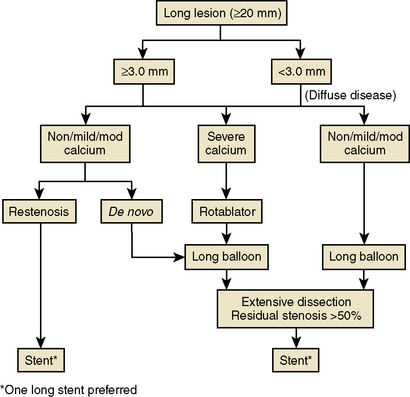9 Difficult Subsets for Percutaneous Coronary Interventions Calcific Vessels, Coronary Bypass Conduits, Elderly Patients, and Cardiac Transplantation
Severely Calcified Stenoses
Rotational atherectomy (Rotablator, see Chapter 6) may be used primarily in this type of lesion, particularly in view of the increased complications and dissection rates from balloon angioplasty. The value of the Flextome Cutting Balloon (Boston Scientific Corporation, Natick, MA) or the AngioSculpt Balloon (Vascular Solutions, Minneapolis, MN) is less certain in this setting.
Long and Diffuse Lesions
PCI of long, diffuse lesions with or without calcification can be managed by long balloon catheters, rotational atherectomy, and stents. After rotablation, balloon lengths of 30 mm and 40 mm followed by similar lengths of stent can cover long diseased segments, reducing the risk of dissection. A graduated dilation approach can be used by introducing progressively larger inflation balloons. If the lesion is heavily calcified, Rotablator should be used first. An algorithm for approaching long lesions is shown in Figure 9-1. Key points for calcified lesions are shown in Table 9-1.

Figure 9-1 Potential approach to the treatment of long lesions and diffuse disease.
(From Topol EJ. Textbook of cardiovascular medicine. Philadelphia: Saunders, 2000: 376.)
Table 9-1 Key Points for Highly Calcified Lesions



